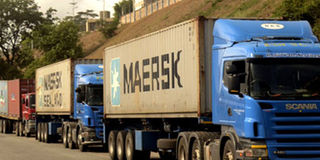Clearing of goods at Mombasa eased as new charter is signed

Trucks leave Mombasa Port. The newly signed charter is expected to increase port efficiency by reducing the days taken to clear cargo. FILE PHOTO
What you need to know:
Timeline. New accomplishments to be realised by 2016.
Mombasa.
Clearing of goods at Mombasa port is expected to be much quicker as public ports agencies commit to improving efficiency of the facility.
The agencies that operate within the port, on Monday signed a Charter that was endorsed by Kenyan President Uhuru Kenyatta, aimed at completely eliminating cargo delays.
For the initiative to work, the port of Mombasa will be operating for 24 hours and be subjected to a monitoring electronic dashboard which will benchmark the efficiency of the commitment made by the agencies.
President Kenyatta said: “This port if run effectively and efficiently will be seen as an engine of growth, source of employment and new opportunities not only for Kenyans but also transform the East African region.” Mr Kenyatta expressed his government’s support for the initiative and urged the agencies to live up to their commitment and the private sector served by the port to play their role too.
Mombasa Port is the entry point to Kenya and East Africa, and the key cargo point for road and rail trade along the Northern Corridor that connects to markets in Kenya, Uganda, Rwanda and Burundi as well as southern Sudan, eastern DRC, and parts of northern Tanzania.
The port handles at least 30 per cent of goods destined to Uganda, Rwanda and South Sudan and experts say measures to reduce delays will reduce the cost of doing business.
Mr Charles Kareba, the managing director Kargo International Ltd, a Ugandan clearing company, reacting to the charter and commitment made by Kenya ports agencies said: “This is good news for us Ugandans. If they implement and live up to their promise, we will benefit and reduce on the delays and save money.”
Trade Mark East Africa and Kenya country director Chris Kiptoo said: “Despite the East African region being the second fastest growing region in the world economically, it is the second most expensive region to do business in the world.”
port developments
The developments to be undertaken include dredging of the port to 15 metres to accommodate larger vessels, construction of Berth 19 with a quay length of 240m giving a total quay length of 840m, on-going construction of the second container terminal.




